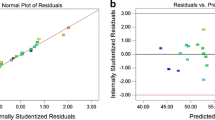Abstract
Spheres are widely used as the basis for the design of multiparticulate drug delivery systems. Although the extrusion and spheronization processes are frequently used to produce such spheres, there is a lack of basic understanding of these processes and of the requisite properties of excipients and formulations. It is hypothesized that the rheological or mechanical properties of the wet mass may address the requirements of both extrusion and spheronization. The fact that certain formulations can be extruded, yet not be successfully spheronized, suggests that the two processes depend on different formulation attributes, and that there are different rheological criteria that must be met for each process to be successful. As a preliminary test of these hypotheses, methods were developed to measure the rheological behavior and mechanical properties (plastic yield value, tensile strength, yield loci) of the wet mass and/or extrudate for a model formulation system (microcrystalline cellulose, lactose, hydroxypropylmethylcellulose). The finished spheres were characterized in terms of particle size, bulk density, individual bead crushing strength, and sphericity. A Box-Behnken experimental design was employed by which the independent formulation variables could be related to the dependent rheological/mechanical properties and finished pellet characteristics. It was observed that there was a critical range of rheological/mechanical variables within which pellets having desirable criteria such as yield of 18/25 mesh cut >60%, a shape factor >0.85, etc., can be prepared. Screen pressure was shown to be the most critical variable affecting the yield of 18/25 mesh cut, while the yield value and tensile strength markedly influenced the shape factor. Thus, for the formulations studied, it was possible to define a “window” of rheological/mechanical properties within which both extrusion and spheronization can be successfully carried out.
Similar content being viewed by others
REFERENCES
J. M. Newton. The preparation of spherical granules by extrusion/spheronization. S.T.P. Pharma. 6, 396–398 (1990).
C. W. Woodruff and N. O. Nuessle. Effect of processing variables on particles obtained by extrusion-spheronization processing. J. Pharm. Sci. 61, 787–790 (1972).
H. J. Malinowski and W. E. Smith. Use of factorial design to evaluate granulations prepared by spheronization. J. Pharm. Sci. 64, 1688–1692 (1975).
H. J. Malinowski and W. E. Smith. Effects of spheronization process variables on selected table properties, J. Pharm. Sci. 63, 285–288 (1974).
I. M. Jalal, H. J. Malinowski, and W. E. Smith. Tablet granulations composed of spherical-shaped particles. J. Pharm. Sci. 61, 1466–1468 (1972).
M. Chariot, J. Frances, G. A. Lewis, D. Mathieu, R. Phan Tan Luu, and H. N. E. Stevens. A factorial approach to process variables of extrusion-spheronization of wet powder masses. Drug Dev. Ind. Pharm., 13, 1639–1649 (1987).
P. J. Harrison, J. M. Newton, and R. C. Rowe. The characterization of wet powder masses suitable for extrusion/spheronization. J. Pharm. Pharmacol. 37, 686–691 (1985).
P. J. Harrison. Extrusion of wet powder masses. Ph.D. Dissertation, University of London, Chelsea College (1982).
K. E. Fielden, J. M. Newton, and R. C. Rowe. The effect of lactose particle size on the extrusion properties of microcrystalline cellulose-lactose mixtures. J. Pharm. Pharmacol. 41, 217–221 (1989).
I. Ghebre-Sellassie. Pharmaceutical Pelletization Technology. Marcel Dekker, New York, NY, 1989.
R. E. O'Connor, J. Holinej, and J. B. Schwartz. Spheronization I: processing and evaluation of spheres prepared from commercially available excipients. Am. J. Pharm. 156, 80–87 (1984).
R. C. Rowe and G. R. Sadeghnejad. The rheology of microcrystalline cellulose powder/water mixes-measurement using a mixer torque rheometer. Int. J. Pharm. 38, 227–229 (1987).
K. E. Fielden, J. M. Newton, P. O'Brien and R. C. Rowe. Thermal studies on the interaction of water and microcrystalline cellulose. J. Pharm. Pharmacol. 40, 674–678 (1988).
G. Zhang, J. B. Schwartz, and R. L. Schnaare. Effect of spheronization technique on drug release from uncoated beads. Drug Dev. Ind. Pharm. 16, 1171–1184 (1990).
G. P. Millili and J. B. Schwartz. The strength of microcrystalline cellulose pellets: The effect of granulating with water/ethanol mixtures. Drug Dev. Ind. Pharm. 16, 1411–1426 (1990).
G. P. Millili, R. J. Wignet, and J. B. Schwartz. Autohesion in pharmaceutical solids. Drug Dev. Ind. Pharm. 16, 2383–2407 (1990).
I. A. S. Z. Peschl. Measurement and evaluation of mechanical properties of powders. Powder Handling & Processing. 1, 135–141 (1989).
R. D. Shah, M. Kabadi, D. G. Pope, and L. L. Augsburger. Physico-mechanical characterization of the extrusion-spheronization process; Part-I: Instrumentation of the extruder. Pharm. Res. 11, 355–360 (1994).
H. Schubert. Tensile strength of agglomerates. Powder Tech., 11, 107–119 (1975).
K. B. Shah, L. L. Augsburger, and K. Marshall. An investigation of some factors influencing plug formation and fill weight in a dosing disk-type automatic capsule-filling machine. J. Pharm. Sci., 75, 291–296 (1986).
J. S. Murray, Jr. X-STAT software manual. John Wiley & Sons, Inc., New York, NY.
C. G. Barlow. The granulation of powders. Chem. Engr. No. 220, CE196–CE201 (1968).
H. G. Kristensen, P. Holm, and T. Schaefer. Mechanical properties of moist agglomerates in relation to granulation mechanisms; Part I. Deformability of moist, densified agglomerates. Powder Tech. 44, 227–237 (1985).
M. J. Gamlen and C. Eardley. Continuous extrusion using a Baker Perkins MP50 (Multipurpose) extruder. Drug Dev. Ind. Pharm. 12, 1701–1713 (1986).
N.-O. Lindberg, C. Tufvesson and L. Olbjer. Extrusion of an effervescent granulation with a twin screw extruder, Baker Perkins MPF 50 D. Drug. Dev. Ind. Pharm. 13, 1891–1913 (1987).
K. Lovgren. Disintegrants and fillers in the manufacture of spheres, their influence on dissolution rates and binding properties. Labo-Pharma-Probl. Tech. 32, 110–114 (1984).
U. Shah, unpublished results.
K. Lovgren and P. J. Lundberg. Determination of sphericity of pellets prepared by extrusion/spheronization and the impact of some process parameters. Drug Dev. Ind. Pharm. 15, 2375–2392 (1989).
Rights and permissions
About this article
Cite this article
Shah, R.D., Kabadi, M., Pope, D.G. et al. Physico-Mechanical Characterization of the Extrusion-Spheronization Process. Part II: Rheological Determinants for Successful Extrusion and Spheronization. Pharm Res 12, 496–507 (1995). https://doi.org/10.1023/A:1016237509740
Issue Date:
DOI: https://doi.org/10.1023/A:1016237509740




